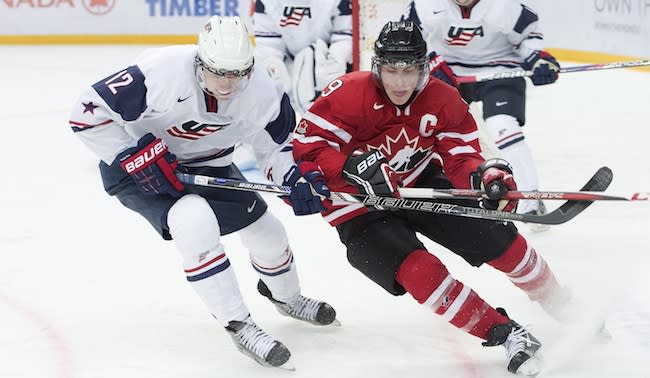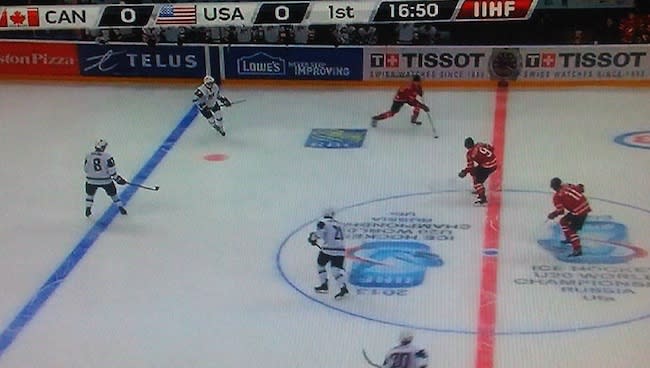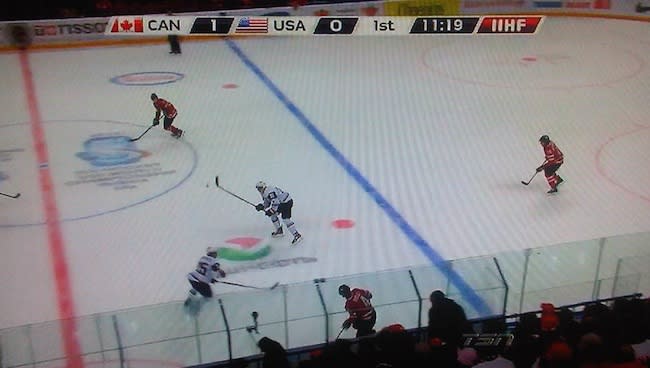World junior championship: Canada finds success against USA with more aggressive attack
It was fairly apparent early on in Team Canada's latest game that an American team coached by Phil Housley would be a much tougher test for Steve Spott's group than Germany or Slovakia. Players developed in less hockey-friendly nations don't run hard systems, and their defensive strategy usually involves lining up players to poke check the puck carrier, like henchmen in action movies. Also like henchmen in action movies, they have a very small success rate at separating a Canadian player from the puck.
One way you can tell how strong a defensive system is by how the offensive team entered the zone. In charting out zone entries in the games against Slovakia and Germany, the Canadians had no trouble carrying the puck into the zone, but they were stymied early on against an American team. Housley predominantly used his checkers in the early part of this game, and it wasn't until Canada turned to a more attacking style that they were able to successfully bring the puck in and hope for chances.
The genesis for this is from Eric T. over at NHLNumbers, who showed during the summer that teams were more likely to generate shots and scoring chances on plays where the puck was carried into the zone rather than dumped-and-chased. This is intuitive, since the dump-and-chase play is analogous to a punt in football, where a team is essentially conceding possession of the puck for a better spot on the ice. Eric found that NHL-level players showed little disparity in actual offensive zone ability, but the difference between players lay in their ability to bring the puck into the zone.
Taking on somewhat of a different approach here, I tracked entries—carries and dumps—for Canada in their first two games. When they carried the puck into the zone, they earned a scoring chance 34.4% of the time at even strength. On a dump play, even when eliminating dump plays that resulted in a line change, that was just 5.7%. Part of the problem with Canada's powerplay in the early game against Germany is that in the first period, Canada exclusively tried to gain the zone with dumps and long passes rather than speed and skill, which essentially negates their advantage over a team like the Germans who don't have a trapping system in place to stop them.
With that in mind, I wanted to see how individual players would react to the trap set up by Housley. Early in the game, they were getting shut down, successful in just four of their six attempts to carry the puck into the zone. After that, Canada began getting more aggressive in the neutral zone, using their speed to create entries. They were outplayed at even strength, but they did muster a fairly successful attack against John Gibson and the American defence.
Look at this early attempt, a more conservative version. Morgan Rielly sees two oncoming American forecheckers. He slowly moves the puck up to the point:
There, he's greeted by a third, and casually dumps the puck off to Ryan Nugent-Hopkins, who doesn't receive the puck cleanly. Even if he did, he's protected on both sides by American checkers, and, though they aren't visible in the frame, the two American defenders who closed down neatly on rushers. What Nugent-Hopkins tried to do was use an extra pass wide to Mark Scheifele:
Jonathan Huberdeau had to come over from his position in support, and Canada is cluttered. The three strongest, most skilled players on the team are forced to one side based on the conservative decision by Rielly. Canada doesn't gain the zone:
Other than Nugent-Hopkins mishandling the early attempt, the key fault lay with Rielly, or his instructor, to keep the play moving slowly through the zone. Eventually, Canada would resort to a stretch pass across the ice, and Scheifele was on the receiving end often. The team wouldn't dawdle in their own end, getting the puck out of the zone decisively and using their speed to out-class the Americans.
This comes later in the period, same players. Morgan Rielly has the puck behind his own net, watched by two American forecheckers:
Rather than slowly move the puck to the blue line, Rielly quickly moves out behind his defenceman Tyler Wotherspoon, who is a pylon on this play. He isn't necessary, since the Americans have thrown two guys at Rielly. Rielly is faster than both of them, and knows the puck can move faster than any one player. Once at the line, he sends the puck wide:
Huberdeau, there, can greet the puck in space:
Unfortunately, Nathan MacKinnon, who was Huberdeau's line mate here, anticipated Huberdeau receiving the puck cleanly and put himself offside. However Canada made the effective adjustment of putting the pucks further wide, exposing an American weakness in their 2-1-2. The counter-attack, particularly instigated by Nugent-Hopkins and Schiefele, was very successful at moving the puck into the American zone. The European ice surface generally benefits teams that can use a tactical trap, but in this case, playing a faster, North-South game, benefit the Canadians.
Here are the success rates for Canadians trying to enter the zone in the 2-1 win versus the USA. It shows us a bit about the importance of each player in their line. For instance, while Ryan Strome scores goals, it was Jonathan Drouin who controlled the play for the most part on the entry, which is perhaps the more important talent:
Entries | Attempts | % | |
|---|---|---|---|
Mark Scheifele | 6 | 6 | 100% |
Jonathan Huberdeau | 6 | 10 | 60% |
Mark McNeill | 3 | 3 | 100% |
Morgan Rielly | 3 | 3 | 100% |
Jonathan Drouin | 3 | 3 | 100% |
Brett Ritchie | 3 | 4 | 75% |
Ryan Nugent-Hopkins | 3 | 4 | 75% |
Phillip Danault | 3 | 4 | 75% |
Anthony Camara | 3 | 5 | 60% |
Ryan Strome | 2 | 2 | 100% |
Ty Rattie | 2 | 3 | 67% |
Ryan Murphy | 2 | 4 | 50% |
Scott Harrington | 1 | 1 | 100% |
Xavier Ouellet | 1 | 1 | 100% |
Tyler Wotherspoon | 1 | 2 | 50% |
Nathan MacKinnon | 1 | 2 | 50% |
Scheifele, Huberdeau and Nugent-Hopkins each had good success rates and a good number of carries. The dump-and-chase style was practically wiped from the game plan, as even the Canadian role players such as Anthony Camara and Brett Ritchie moved the puck successfully. This was in stark contrast to the game against the Slovakians, where a timid Canadian team dumped the puck nearly 40% of the time. Whether there was a switch that Spott could simply turn on, or if the game plan was merely adjusted, Canada looked like the much stronger overall unit against the Americans, playing aggressively and attempting to conquer them with speed. Of course, this is also representative of a single game, and it's likely Russia will throw a different look at Canadian forwards, forcing them to do something else with the puck in the neutral zone.
Now, if there's just a way to adjust for defensive zone giveaways, I'm sure Spott is all ears...

 Yahoo Sports
Yahoo Sports 








